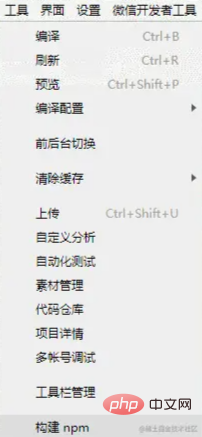詳解微信小程式中如何安裝和引用ECharts?
這篇文章為大家介紹微信小程式中使用 npm 引入 ECharts 的方法,希望對大家有幫助!

Apache ECharts 官方提供了在微信小程式中使用Echarts 的程式碼實例和ec-canvas 元件,但未發布npm 套件。
此專案在官方程式碼之上修改支持ec-canvas# 元件傳入echarts 可支援npm 引入echarts 或本機自訂建置後的echarts,更符合Web 開發體驗。
並且發布 npm 包,支援小程式透過 npm 安裝使用。並支援 Taro 按需引入 echarts 減少打包體積。 【相關學習推薦:小程式開發教學】
安裝
npm install echarts-for-weixin
小程式引用
參考程式碼tools/demo
#1、先在頁面的json 檔案加入usingComponents 設定欄位
{
"usingComponents": {
"ec-canvas": "echarts-for-weixin"
}
}2、專案根目錄建立package.json 並執行npm install 安裝依賴
{
"dependencies": {
"echarts": "^5.1.2",
"echarts-for-weixin": "^1.0.0"
}
}3、小程式開發者工具中建構npm
點選開發者工具中的功能表列:工具--> 建立npm

# 4.在頁面中引入echarts,可以從npm 引入echarts,也可以引入本地自訂建構的
以減少體積
import * as echarts from 'echarts' // 从 npm 引入 echarts import * as echarts from './echarts' // 或者从本地引入自定义构建的 echarts
5、然後可以在對應頁面的wxml 中直接使用該元件<div class="code" style="position:relative; padding:0px; margin:0px;"><pre class='brush:php;toolbar:false;'><view class="container">
<ec-canvas id="mychart-dom-bar" canvas-id="mychart-bar" echarts="{{ echarts }}" ec="{{ ec }}"></ec-canvas>
</view></pre><div class="contentsignin">登入後複製</div></div>6、ec-canvas 的具體用法和如何初始化圖表請參考
import * as echarts from 'echarts'
let chart = null;
function initChart(canvas, width, height, dpr) {
chart = echarts.init(canvas, null, {
width: width,
height: height,
devicePixelRatio: dpr // new
});
canvas.setChart(chart);
var option = {
tooltip: {
trigger: 'axis',
axisPointer: { // 坐标轴指示器,坐标轴触发有效
type: 'shadow' // 默认为直线,可选为:'line' | 'shadow'
},
confine: true
},
legend: {
data: ['热度', '正面', '负面']
},
grid: {
left: 20,
right: 20,
bottom: 15,
top: 40,
containLabel: true
},
xAxis: [
{
type: 'value',
axisLine: {
lineStyle: {
color: '#999'
}
},
axisLabel: {
color: '#666'
}
}
],
yAxis: [
{
type: 'category',
axisTick: { show: false },
data: ['汽车之家', '今日头条', '百度贴吧', '一点资讯', '微信', '微博', '知乎'],
axisLine: {
lineStyle: {
color: '#999'
}
},
axisLabel: {
color: '#666'
}
}
],
series: [
{
name: '热度',
type: 'bar',
label: {
normal: {
show: true,
position: 'inside'
}
},
data: [300, 270, 340, 344, 300, 320, 310],
itemStyle: {
// emphasis: {
// color: '#37a2da'
// }
}
},
{
name: '正面',
type: 'bar',
stack: '总量',
label: {
normal: {
show: true
}
},
data: [120, 102, 141, 174, 190, 250, 220],
itemStyle: {
// emphasis: {
// color: '#32c5e9'
// }
}
},
{
name: '负面',
type: 'bar',
stack: '总量',
label: {
normal: {
show: true,
position: 'left'
}
},
data: [-20, -32, -21, -34, -90, -130, -110],
itemStyle: {
// emphasis: {
// color: '#67e0e3'
// }
}
}
]
};
chart.setOption(option);
return chart;
}
Page({
data: {
echarts,
ec: {
onInit: initChart
}
},
onReady() {
setTimeout(function () {
// 获取 chart 实例的方式
console.log(chart)
}, 2000);
}
})Taro 引用#參考程式碼
- 準備工作
npm install echarts-for-weixin
登入後複製登入後複製登入後複製在專案根目錄中新檔案project.package.json或自訂命名,此檔案是小程式的package.json,並在下一步中新增小程式自訂建置npm 方式。這麼做的目的是為了能夠共享專案 node_modules
{ "dependencies": { "echarts": "^5.1.2", "echarts-for-weixin": "^1.0.2" } }登入後複製#在project.config的setting 中新增小程式自訂建置npm 方式,參考 自訂node_modules 和miniprogram_npm 位置的建置npm 方式
{ "setting": { "packNpmManually": true, "packNpmRelationList": [ { "packageJsonPath": "../project.package.json", "miniprogramNpmDistDir": "./" } ] } }登入後複製執行Taro
npm run dev:weapp
登入後複製登入後複製小程式開發者工具中建置npm。注意:小程式開發工具開啟的專案目錄是dist
點選開發者工具中的功能表列:工具--> 建立npm
- #引入Echarts
在全域的app.config.js中新增或在單一需要使用到 echarts
{ "usingComponents": { "ec-canvas": "echarts-for-weixin" } }登入後複製登入後複製登入後複製在頁面中引入echarts,可以從npm引入echarts,也可以引入本地自訂建置的 echarts
import * as echarts from 'echarts' // 从 npm 引入 echarts import * as echarts from './echarts' // 或者从本地引入自定义构建的 echarts
登入後複製登入後複製將引入的echarts
- #
<ec-canvas id='mychart-dom-area' canvas-id='mychart-area' echarts={echarts} // 将引入的 echarts 传给组件 ec={this.state.ec} />登入後複製登入後複製ec-canvas 的具體用法和如何初始化圖表請參考Echarts 官方小程式範例
function initChart(canvas, width, height) { const chart = echarts.init(canvas, null, { width: width, height: height
})
canvas.setChart(chart) const model = { yCates: ['Saturday', 'Friday', 'Thursday', 'Wednesday', 'Tuesday', 'Monday', 'Sunday'], xCates: ['1', '2', '3', '4', '5'], data: [ // [yCateIndex, xCateIndex, value]
[0, 0, 5], [0, 1, 7], [0, 2, 3], [0, 3, 5], [0, 4, 2],
[1, 0, 1], [1, 1, 2], [1, 2, 4], [1, 3, 8], [1, 4, 2],
[2, 0, 2], [2, 1, 3], [2, 2, 8], [2, 3, 6], [2, 4, 7],
[3, 0, 3], [3, 1, 7], [3, 2, 5], [3, 3, 1], [3, 4, 6],
[4, 0, 3], [4, 1, 2], [4, 2, 7], [4, 3, 8], [4, 4, 9],
[5, 0, 2], [5, 1, 2], [5, 2, 3], [5, 3, 4], [5, 4, 7],
[6, 0, 6], [6, 1, 5], [6, 2, 3], [6, 3, 1], [6, 4, 2]
]
} const data = model.data.map(function (item) { return [item[1], item[0], item[2] || '-']
}) const option = { tooltip: { position: 'top'
}, animation: false, grid: { bottom: 60, top: 10, left: 80
}, xAxis: { type: 'category', data: model.xCates
}, yAxis: { type: 'category', data: model.yCates
}, visualMap: { min: 1, max: 10, show: false, calculable: true, orient: 'horizontal', left: 'center', bottom: 10, inRange: { color: ['#37A2DA', '#32C5E9', '#67E0E3', '#91F2DE', '#FFDB5C', '#FF9F7F'],
}
}, series: [{ name: 'Punch Card', type: 'heatmap', data: data, label: { normal: { show: true
}
}, itemStyle: { emphasis: { shadowBlur: 10, shadowColor: 'rgba(0, 0, 0, 0.5)'
}
}
}]
}
chart.setOption(option) return chart
}export default class Echarts extends React.Component {
state = { ec: { onInit: initChart
}
}
render () { return ( <View className='echarts'> <ec-canvas
id='mychart-dom-area'
canvas-id='mychart-area'
echarts={echarts}
ec={this.state.ec}
/> </View>
)
}
}复制代码登入後複製
function initChart(canvas, width, height) { const chart = echarts.init(canvas, null, { width: width, height: height
})
canvas.setChart(chart) const model = { yCates: ['Saturday', 'Friday', 'Thursday', 'Wednesday', 'Tuesday', 'Monday', 'Sunday'], xCates: ['1', '2', '3', '4', '5'], data: [ // [yCateIndex, xCateIndex, value]
[0, 0, 5], [0, 1, 7], [0, 2, 3], [0, 3, 5], [0, 4, 2],
[1, 0, 1], [1, 1, 2], [1, 2, 4], [1, 3, 8], [1, 4, 2],
[2, 0, 2], [2, 1, 3], [2, 2, 8], [2, 3, 6], [2, 4, 7],
[3, 0, 3], [3, 1, 7], [3, 2, 5], [3, 3, 1], [3, 4, 6],
[4, 0, 3], [4, 1, 2], [4, 2, 7], [4, 3, 8], [4, 4, 9],
[5, 0, 2], [5, 1, 2], [5, 2, 3], [5, 3, 4], [5, 4, 7],
[6, 0, 6], [6, 1, 5], [6, 2, 3], [6, 3, 1], [6, 4, 2]
]
} const data = model.data.map(function (item) { return [item[1], item[0], item[2] || '-']
}) const option = { tooltip: { position: 'top'
}, animation: false, grid: { bottom: 60, top: 10, left: 80
}, xAxis: { type: 'category', data: model.xCates
}, yAxis: { type: 'category', data: model.yCates
}, visualMap: { min: 1, max: 10, show: false, calculable: true, orient: 'horizontal', left: 'center', bottom: 10, inRange: { color: ['#37A2DA', '#32C5E9', '#67E0E3', '#91F2DE', '#FFDB5C', '#FF9F7F'],
}
}, series: [{ name: 'Punch Card', type: 'heatmap', data: data, label: { normal: { show: true
}
}, itemStyle: { emphasis: { shadowBlur: 10, shadowColor: 'rgba(0, 0, 0, 0.5)'
}
}
}]
}
chart.setOption(option) return chart
}export default class Echarts extends React.Component {
state = { ec: { onInit: initChart
}
}
render () { return ( <View className='echarts'> <ec-canvas
id='mychart-dom-area'
canvas-id='mychart-area'
echarts={echarts}
ec={this.state.ec}
/> </View>
)
}
}复制代码Taro 按需引用參考代碼
注意:小程式開發者工具打開的專案目錄是打包後的
目錄
準備工作
####1、安裝依賴####npm install echarts-for-weixin
2、在项目根目录中新建文件 project.package.json 或者自定义命名,此文件是小程序的 package.json,并在下一步中添加小程序自定义构建 npm 方式。并配置 config/index.js 中的 copy 选项,将 project.package.json 复制到 dist 目录下并且重命名为 package.json。并且复制 node_modules/echarts-for-weixin 至 dist/node_modules/echarts-for-weixin 避免在小程序开发者工具中打开的项目重新安装依赖
project.package.json
{
"dependencies": {
"echarts-for-weixin": "^1.0.2"
}
}config/index.js
{
copy: {
patterns: [
{ from: 'project.package.json', to: 'dist/package.json' }, // 指定需要 copy 的文件
{ from: 'node_modules/echarts-for-weixin/', to: 'dist/node_modules/echarts-for-weixin/' }
],
options: {}
}
}3、在 project.config 的 setting 中添加小程序自定义构建 npm 方式,参考 自定义 node_modules 和 miniprogram_npm 位置的构建 npm 方式
{
"setting": {
"packNpmManually": true,
"packNpmRelationList": [
{
"packageJsonPath": "./package.json",
"miniprogramNpmDistDir": "./"
}
]
}
}4、执行 Taro 的开发或者打包命令进行项目开发
npm run dev:weapp
5、小程序开发者工具中构建 npm。注意:小程序开发工具打开的项目目录是 dist 文件夹
点击开发者工具中的菜单栏:工具 --> 构建 npm

引入 Echarts
1、在全局的 app.config.js 中添加或者在单个需要使用到 echarts 的页面配置中添加引用组件
{
"usingComponents": {
"ec-canvas": "echarts-for-weixin"
}
}2、在页面中引入 echarts/core 和需要的组件,Taro 打包会只打包引入的组件,这样达到按需引入的目的
// Import the echarts core module, which provides the necessary interfaces for using echarts.
import * as echarts from 'echarts/core';
// Import charts, all with Chart suffix
import {
// LineChart,
BarChart,
// PieChart,
// ScatterChart,
// RadarChart,
// MapChart,
// TreeChart,
// TreemapChart,
// GraphChart,
// GaugeChart,
// FunnelChart,
// ParallelChart,
// SankeyChart,
// BoxplotChart,
// CandlestickChart,
// EffectScatterChart,
// LinesChart,
// HeatmapChart,
// PictorialBarChart,
// ThemeRiverChart,
// SunburstChart,
// CustomChart,
} from 'echarts/charts';
// import components, all suffixed with Component
import {
// GridSimpleComponent,
GridComponent,
// PolarComponent,
// RadarComponent,
// GeoComponent,
// SingleAxisComponent,
// ParallelComponent,
// CalendarComponent,
// GraphicComponent,
// ToolboxComponent,
TooltipComponent,
// AxisPointerComponent,
// BrushComponent,
TitleComponent,
// TimelineComponent,
// MarkPointComponent,
// MarkLineComponent,
// MarkAreaComponent,
// LegendComponent,
// LegendScrollComponent,
// LegendPlainComponent,
// DataZoomComponent,
// DataZoomInsideComponent,
// DataZoomSliderComponent,
// VisualMapComponent,
// VisualMapContinuousComponent,
// VisualMapPiecewiseComponent,
// AriaComponent,
// TransformComponent,
DatasetComponent,
} from 'echarts/components';
// Import renderer, note that introducing the CanvasRenderer or SVGRenderer is a required step
import {
CanvasRenderer,
// SVGRenderer,
} from 'echarts/renderers';
// Register the required components
echarts.use(
[
TitleComponent,
TooltipComponent,
GridComponent,
BarChart,
CanvasRenderer,
HeatmapChart,
VisualMapComponent,
VisualMapContinuousComponent,
VisualMapPiecewiseComponent,
]
);3、将引入的 echarts 传给组件
<ec-canvas
id='mychart-dom-area'
canvas-id='mychart-area'
echarts={echarts} // 将引入的 echarts 传给组件
ec={this.state.ec}
/>4、ec-canvas 的具体用法和如何初始化图表请参考 Echarts 官方小程序示例
function initChart(canvas, width, height) {
const chart = echarts.init(canvas, null, {
width: width,
height: height
})
canvas.setChart(chart)
const model = {
yCates: ['Saturday', 'Friday', 'Thursday',
'Wednesday', 'Tuesday', 'Monday',
'Sunday'],
xCates: ['1', '2', '3', '4', '5'],
data: [
// [yCateIndex, xCateIndex, value]
[0, 0, 5], [0, 1, 7], [0, 2, 3], [0, 3, 5], [0, 4, 2],
[1, 0, 1], [1, 1, 2], [1, 2, 4], [1, 3, 8], [1, 4, 2],
[2, 0, 2], [2, 1, 3], [2, 2, 8], [2, 3, 6], [2, 4, 7],
[3, 0, 3], [3, 1, 7], [3, 2, 5], [3, 3, 1], [3, 4, 6],
[4, 0, 3], [4, 1, 2], [4, 2, 7], [4, 3, 8], [4, 4, 9],
[5, 0, 2], [5, 1, 2], [5, 2, 3], [5, 3, 4], [5, 4, 7],
[6, 0, 6], [6, 1, 5], [6, 2, 3], [6, 3, 1], [6, 4, 2]
]
}
const data = model.data.map(function (item) {
return [item[1], item[0], item[2] || '-']
})
const option = {
tooltip: {
position: 'top'
},
animation: false,
grid: {
bottom: 60,
top: 10,
left: 80
},
xAxis: {
type: 'category',
data: model.xCates
},
yAxis: {
type: 'category',
data: model.yCates
},
visualMap: {
min: 1,
max: 10,
show: false,
calculable: true,
orient: 'horizontal',
left: 'center',
bottom: 10,
inRange: {
color: ['#37A2DA', '#32C5E9', '#67E0E3', '#91F2DE', '#FFDB5C', '#FF9F7F'],
}
},
series: [{
name: 'Punch Card',
type: 'heatmap',
data: data,
label: {
normal: {
show: true
}
},
itemStyle: {
emphasis: {
shadowBlur: 10,
shadowColor: 'rgba(0, 0, 0, 0.5)'
}
}
}]
}
chart.setOption(option)
return chart
}
export default class Echarts extends React.Component {
state = {
ec: {
onInit: initChart
}
}
render () {
return (
<View className='echarts'>
<ec-canvas
id='mychart-dom-area'
canvas-id='mychart-area'
echarts={echarts}
ec={this.state.ec}
/>
</View>
)
}
}5、可以查看小程序开发者工具中的依赖分析,确定文件大小以及是否正确按需引入

更多编程相关知识,请访问:编程入门!!
以上是詳解微信小程式中如何安裝和引用ECharts?的詳細內容。更多資訊請關注PHP中文網其他相關文章!

熱AI工具

Undresser.AI Undress
人工智慧驅動的應用程序,用於創建逼真的裸體照片

AI Clothes Remover
用於從照片中去除衣服的線上人工智慧工具。

Undress AI Tool
免費脫衣圖片

Clothoff.io
AI脫衣器

Video Face Swap
使用我們完全免費的人工智慧換臉工具,輕鬆在任何影片中換臉!

熱門文章

熱工具

記事本++7.3.1
好用且免費的程式碼編輯器

SublimeText3漢化版
中文版,非常好用

禪工作室 13.0.1
強大的PHP整合開發環境

Dreamweaver CS6
視覺化網頁開發工具

SublimeText3 Mac版
神級程式碼編輯軟體(SublimeText3)
 閒魚微信小程式正式上線
Feb 10, 2024 pm 10:39 PM
閒魚微信小程式正式上線
Feb 10, 2024 pm 10:39 PM
閒魚官方微信小程式悄悄上線,在小程式中可以發布閒置與買家/賣家私訊交流、查看個人資料及訂單、搜尋物品等,有用好奇閒魚微信小程式叫什麼,現在快來看一下。閒魚微信小程式叫什麼答案:閒魚,閒置交易二手買賣估價回收。 1、在小程式中可以發布閒置、與買家/賣家私訊交流、查看個人資料及訂單、搜尋指定物品等功能;2、在小程式的頁面中有首頁、附近、發閒置、訊息、我的5項功能;3、想要使用的話必要要開通微信支付才可以購買;
 ECharts與Java介面:如何快速實現折線圖、長條圖、圓餅圖等統計圖
Dec 17, 2023 pm 10:37 PM
ECharts與Java介面:如何快速實現折線圖、長條圖、圓餅圖等統計圖
Dec 17, 2023 pm 10:37 PM
ECharts和Java介面:如何快速實現折線圖、長條圖、圓餅圖等統計圖,需要具體程式碼範例隨著網路時代的到來,資料分析變得越來越重要。統計圖表是一種非常直觀而有力的展示方式,透過圖表可以更清楚地展示數據,讓人們更能理解數據的內涵和規律。在Java開發中,我們可以使用ECharts和Java介面來快速實現各種統計圖表的展示。 ECharts是一款由百度開發
 如何利用php介面和ECharts產生可視化的統計圖表
Dec 18, 2023 am 11:39 AM
如何利用php介面和ECharts產生可視化的統計圖表
Dec 18, 2023 am 11:39 AM
在今天數據視覺化變得越來越重要的背景下,許多開發者都希望能夠利用各種工具,快速產生各種圖表與報表,以便能夠更好的展示數據,幫助決策者快速做出判斷。而在此背景下,利用Php介面和ECharts函式庫可以幫助許多開發者快速產生可視化的統計圖表。本文將詳細介紹如何利用Php介面和ECharts庫產生視覺化的統計圖表。在具體實作時,我們將使用MySQL
 使用ECharts和Python介面繪製儀錶板的步驟
Dec 18, 2023 am 08:40 AM
使用ECharts和Python介面繪製儀錶板的步驟
Dec 18, 2023 am 08:40 AM
使用ECharts和Python介面繪製儀錶板的步驟,需要具體程式碼範例摘要:ECharts是一款優秀的資料視覺化工具,透過Python介面可以方便地進行資料處理和圖形繪製。本文將介紹使用ECharts和Python介面繪製儀錶板的具體步驟,並提供範例程式碼。關鍵字:ECharts、Python介面、儀錶板、資料視覺化簡介儀錶板是一種常用的資料視覺化形式,它透過
 如何在ECharts中使用地圖熱力圖展示城市熱度
Dec 18, 2023 pm 04:00 PM
如何在ECharts中使用地圖熱力圖展示城市熱度
Dec 18, 2023 pm 04:00 PM
如何在ECharts中使用地圖熱力圖展示城市熱度ECharts是一款功能強大的視覺化圖表庫,它提供了各種圖表類型供開發人員使用,包括地圖熱力圖。地圖熱力圖可以用來展示城市或地區的熱度,幫助我們快速了解不同地方的熱門程度或密集程度。本文將介紹如何使用ECharts中的地圖熱力圖來展示城市熱度,並提供程式碼範例供參考。首先,我們需要一個包含地理資訊的地圖文件,EC
 閒魚微信小程式叫什麼
Feb 27, 2024 pm 01:11 PM
閒魚微信小程式叫什麼
Feb 27, 2024 pm 01:11 PM
閒魚官方微信小程式已經悄悄上線,它為用戶提供了一個便捷的平台,讓你可以輕鬆地發布和交易閒置物品。在小程式中,你可以與買家或賣家進行私訊交流,查看個人資料和訂單,以及搜尋你想要的物品。那麼閒魚在微信小程式中究竟叫什麼呢,這篇教學攻略將為您詳細介紹,想要了解的用戶們快來跟著本文繼續閱讀吧!閒魚微信小程式叫什麼答案:閒魚,閒置交易二手買賣估價回收。 1、在小程式中可以發布閒置、與買家/賣家私訊交流、查看個人資料及訂單、搜尋指定物品等功能;2、在小程式的頁面中有首頁、附近、發閒置、訊息、我的5項功能;3、
 如何在ECharts中使用長條圖展示數據
Dec 18, 2023 pm 02:21 PM
如何在ECharts中使用長條圖展示數據
Dec 18, 2023 pm 02:21 PM
如何在ECharts中使用長條圖展示資料ECharts是一款基於JavaScript的資料視覺化函式庫,在資料視覺化的領域非常流行且使用廣泛。其中,長條圖是最常見和常用的圖表類型,可以用來顯示各種數值資料的大小、比較和趨勢分析。本文將介紹如何使用ECharts來繪製長條圖,並提供程式碼範例。首先,我們需要在HTML檔案中引入ECharts庫,可以透過以下方式引
 ECharts和golang技術指南: 創建各類統計圖表的實用秘籍
Dec 17, 2023 pm 09:56 PM
ECharts和golang技術指南: 創建各類統計圖表的實用秘籍
Dec 17, 2023 pm 09:56 PM
ECharts和golang技術指南:創建各類統計圖表的實用秘籍,需要具體程式碼範例導語:在現代化的資料視覺化領域,統計圖表是資料分析和視覺化的重要工具。 ECharts是一個強大的資料視覺化函式庫,而golang是一種快速,可靠且有效率的程式語言。本文將向您介紹如何使用ECharts和golang建立各種類型的統計圖表,並提供程式碼範例,幫助您掌握這項技能。準備工作






